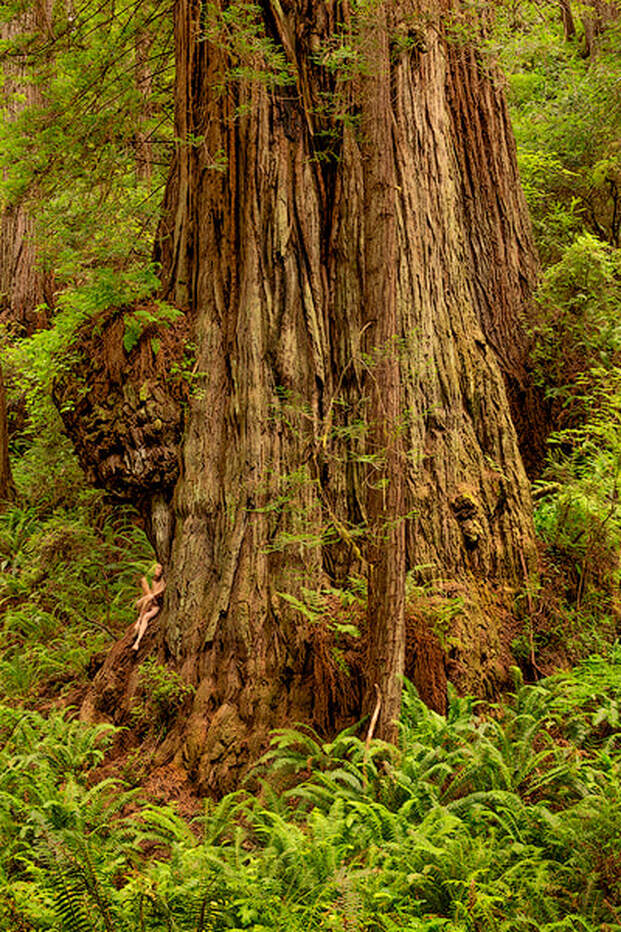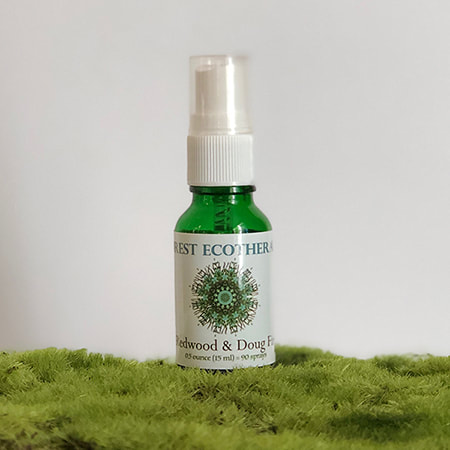Coast Redwood – Sequoia sempervirens
|
Natural History
Other Names: Redwood, California Redwood, Giant Redwood, q̓asil (Kashaya Pomo). Distinctive Characteristics: No flora species in California is more iconic than the Coast Redwood. These trees are legendary for their majestic beauty, towering height, habitat biodiversity, rot-resistant wood, and epic role in environmental activism. Coast Redwood is currently the tallest species of tree on Earth, while its cousin, the Giant Sequoia (Sequoiadendron giganteum), which lives exclusively in the Sierra Nevada range of California, is generally larger in girth and is known for being the world's largest tree by wood volume. There have been recent discoveries of individuals equal in girth to the largest living Giant Sequoias. The species name sempervirens means "evergreen" or "everlasting," and is also known for its longevity. Mature Coast Redwoods are distinguishable from other coniferous trees by their tall, columnar trunks, horizontal drooping branches, and narrowly conical crowns. Trees grow in giant stands that cut through fog and sunlight, appearing like ethereal cathedrals. The soft, fibrous, rusty red to gray bark is up to 1 ft. (0.3 m) thick, with a furrowed texture that is often painted lightly with moss and lichens. This magnificent fire- and insect-resistant bark, along with foliage that doesn't start till high above the ground (up to 100 ft./30 m in mature trees), contributes to the trees' longevity. These trees keep growing until near death, with their rate of wood production increasing as the tree ages (because they have more leaves). Another notable characteristic of the Coast Redwood is its shallow root system. Even the roots of the most ancient individuals extend about only 6 ft. (1.8 m) deep, while their wide-spreading lateral roots interconnect with those of other redwoods for mutual support. Coast Redwoods can reproduce from seeds (assisted by, but not dependent upon, fire) or from dormant epicormic sprouts that form live burl growths at a tree's base. The cones are small, ¾–1½ in. (1.9–3.8 m) long. The adventitious sprouts, which sometimes grow on living trees, are stimulated to grow into full trees when the base of the trunk is cut, burned, or naturally fallen, regenerating a "fairy ring" of trees sprouting along the circumference of the dead parent tree. Because these young trees are technically genetic clones, a circle of trees can continue to expand out for thousands of years, and be considered part of the same tree. These water loving trees survive the dry season by collecting about half of their water needs from fog, letting it fall as "fog drip" to the forest floor, adding 12 inches (300 mm) or more of precipitation during the dry season. Like all trees, they also transpire moisture back into the air, helping to create water vapor that in turn creates clouds. In this way redwoods play a large part in regulating the climate of their coastal areas, and keeping the temperature cool. One can imagine a cooler climate in northern California over a hundred years ago before the majority of the old growth was logged. Redwood forests also store massive amounts of carbon. Distribution: Native to a narrow range of about 450 miles (724 km) from the southwestern tip of Oregon to California's Monterey Bay, and restricted within 35 miles (56 km) of the coast. Elevation: sea level to 3,000 ft. (920 m). Ecosystem: Found in moist coastal and riparian areas along the fog belt (but not directly on the seashore) within flood zones, on steep slopes, and at the top of ridges. Coast Redwoods are found in pure groves with well-developed understory shrubs and plants, as well as being the dominant species in mixed coniferous forests, which, depending on region, can include Western Hemlock, Douglas Fir, Big Leaf Maple, Vine Maple, Sugar Pine, California Bay Laurel, Pacific Madrone, Tanoak, Oregon White Oak, Coast Live Oak, California Black Oak, Pacific Yew, California Nutmeg, Red Alder, Western Dogwood, Torrey Pine, Grand Fir, Western Redcedar, Port Orford Cedar, hazelnut and manzanita. Maximum Age: Over 2,500 years. Maximum Height and Girth: The tallest living Coast Redwood, and tallest tree in the world is currently the Hyperion tree, at 379.1 ft. (115.72 m) in height. New discoveries of trees claim a circumference of 91 ft (27.7 m), matching the girth of the current largest Giant Sequoias. Animal Community: Coast Redwood forests provide habitat for a large variety of creatures, including black bears, mountain lions, bobcats, gray foxes, eagles, Pacific tree frogs, and the rare Pacific giant salamander. Endangered fish such as salmon depend on these ecosystems for their survival in the wild. The Northern spotted owl and marbled murrelet are federally protected threatened and California-endangered bird species whose existence depends upon old-growth habitat. Not only live trees, but also downed trees and standing snags are vital for habitat and regeneration of the forest ecosystem. Individual old-growth redwood canopies are entire ecosystems in themselves, as discovered by botanists and research scientists Stephen Sillett and Marie Antoine. They ascended trees in the ancient Grove of Titans in Northern California and found a unique ecosystem hundreds of feet off the ground that included huckleberry thickets, extensive epiphytic plants including mosses and lichens, thick soil, and animals such as voles and salamanders who had never touched the ground below. Traditional Uses: Medicine: The young foliage was warmed and then applied as a poultice as a treatment for earaches, and the gummy sap was taken from the bottom of the tree, soaked in water, and drunk as a health tonic (Kashaya Pomo, Pomo). A tea from the needles can be used as an expectorant, and as disinfectant for urinary tract infections. A poultice of the bark was used as a treatment for venereal diseases. A tincture of the inner bark was taken to purify the blood. Fiber: Sprouts from burls were used for basketry material (Costanoan). Tools and Objects: Pieces of bark were used to play dolls. Shelter: Slabs of the thick and insulating redwood bark were used to make simple structures (Miwok, Maidu, Kashya Pomo, Ohlone, Yurok, Hupa, Tolowa, Wiyot, Whilkut, Nongatl, Mattole, Sinkyone). Transportation: Canoes were carved out of downed wood (Yurok, Mendocino Indians). Modern Uses: Coast Redwood is one of the most valuable timber species harvested commercially in California and southern Oregon, and is exported worldwide. It is prized for its beautifully rich-colored, lightweight, straight, rot-resistant wood. It has been extremely popular for lumber for houses, decking, and shingles. Old-growth trees are prized even more for their tight-grained durability. Redwood burls are often illegally cut from live trees (which damages the trees), and also salvaged from logged stumps, to make tabletops, veneers, turned bowls, and tourist kitsch. Bark is used for garden mulch. Threats and Conservation: Although not classified threatened or endangered by the U.S. Endangered Species List, they are considered endangered according to the IUCN Redlist. Threats include climate change, air pollution and logging. The clear-cutting and logging of Coast Redwood forests endangers entire watersheds, increasing erosion and landslides and releasing silt into fragile streams and rivers, many of which are habitat for Coho salmon, Chinook salmon, and Steelhead trout. These magnificent fish, once widely abundant and a major food source for California indigenous tribes are now federally threatened species due to over-fishing and the devastating effects of logging. Only 5 percent of the original redwood forests remain, and only 2 percent of the original old growth is left, of which only half is protected. While some ancient groves are protected in national and state parks, many acres are awaiting selective logging or clear-cutting on private land owned by individuals or by corporations such as Weyerhouser, Green Diamond Resource Company, Sierra Pacific Industries, and Humboldt Redwood Company. Even trees on our public lands are not safe. The U.S. Forest Service is one of the largest clear-cutters and loggers in the U.S., with the annihilation to our prized ecosystems paid for by our tax dollars. Activists have been working nonstop since the 1960s within forests and for organizations to protect redwood forests. Many have devoted their lives, and some given their lives, to defending them. Their work—our work—is nowhere near finished. |



